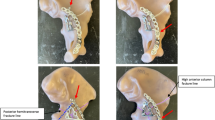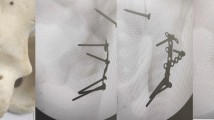Abstract
Correct placement of iliosacral screws remains a surgical challenge. The aim of this retrospective study was to identify parameters which impact the accuracy of this technically demanding procedure. Eighty-two patients with vertically unstable pelvic injuries treated with a total of 147 iliosacral screws were included. Assessment of postoperative CT scans revealed screw misplacement in 13 cases (8%), of which six occurred following insertion of two unilateral screws into S1. Six screw misplacements occurred in patients with dislocation injuries of the posterior pelvis. Comparison of a navigated and the standard technique revealed a decreased screw misplacement rate in the navigated group (15% standard vs. 3% navigation, p < 0.05). In addition, the malposition rate was influenced by the surgeon’s individual experience (20% for low vs. 3.9% for high volume surgeons, p < 0.05). Overall, the accuracy of iliosacral screw placement depends on the number of screws inserted into S1 and the extent of dislocation. In experienced hands, the use of navigation represents a helpful tool to improve the placement accuracy.


Similar content being viewed by others
References
Gebhard F, Weidner A, Liener UC, Stockle U, Arand M (2004) Navigation at the spine. Injury 35(Suppl 1):35–45
Merloz P, Tonetti J, Pittet L, Coulomb M, Lavallee S, Troccaz J et al (1998) Computer-assisted spine surgery. Comput Aided Surg 3(6):297–305
Laine T, Schlenzka D, Makitalo K, Tallroth K, Nolte LP, Visarius H (1997) Improved accuracy of pedicle screw insertion with computer-assisted surgery. A prospective clinical trial of 30 patients. Spine 22(11):1254–1258
Laine T, Lund T, Ylikoski M, Lohikoski J, Schlenzka D (2000) Accuracy of pedicle screw insertion with and without computer assistance: a randomised controlled clinical study in 100 consecutive patients. Eur Spine J 9(3):235–240
Briem D, Linhart W, Lehmann W, Begemann PG, Adam G, Schumacher U et al (2006) Computer-assisted screw insertion into the first sacral vertebra using a three-dimensional image intensifier: results of a controlled experimental investigation. Eur Spine J 15(6):757–763
Grützner PA, Rose E, Vock B, Holz F, Nolte LP, Wentzensen A (2002) Computer-assisted screw osteosynthesis of the posterior pelvic ring. Initial experiences with an image reconstruction based optoelectronic navigation system. Unfallchirurg 105(3):254–260
Stockle U, Krettek C, Pohlemann T, Messmer P (2004) Clinical applications—pelvis. Injury 35(Suppl 1):46–56
Matta JM, Saucedo T (1989) Internal fixation of pelvic ring fractures. Clin Ortop 242:83–97
Tonetti J, Carrat L, Blendea S, Merloz P, Troccaz J, Lavallee S et al (2001) Clinical results of percutaneous pelvic surgery. Computer assisted surgery using ultrasound compared to standard fluoroscopy. Comput Aided Surg 6(4):204–211
Gautier E, Bachler R, Heini PF, Nolte LP (2001) Accuracy of computer-guided screw fixation of the sacroiliac joint. Clin Ortop 393:310–317
Stockle U, Konig B, Hofstetter R, Nolte LP, Haas NP (2001) Navigation assisted by image conversion. An experimental study on pelvic screw fixation. Unfallchirurg 104(3):215–220
Hinsche AF, Giannoudis PV, Smith RM (2002) Fluoroscopy-based multiplanar image guidance for insertion of sacroiliac screws. Clin Ortop 395:135–144
Routt ML Jr, Simonian PT, Mills WJ (1997) Iliosacral screw fixation: early complications of the percutaneous technique. J Orthop Trauma 11(8):584–589
Templeman D, Goulet J, Duwelius PJ, Olson S, Davidson M (1996) Internal fixation of displaced fractures of the sacrum. Clin Ortop 329:180–185
Arand M, Kinzl L, Gebhard F (2002) Sources of error and risks in CT based navigation. Orthopade 31(4):378–384
Reilly MC, Bono CM, Litkouhi B, Sirkin M, Behrens FF (2003) The effect of sacral fracture malreduction on the safe placement of iliosacral screws. J Orthop Trauma 17(2):88–94
Ebraheim NA, Xu R, Biyani A, Nadaud MC (1997) Morphologic considerations of the first sacral pedicle for iliosacral screw placement. Spine 22(8):841–846
Arand M, Kinzl L, Gebhard F (2004) Computer-guidance in percutaneous screw stabilization of the iliosacral joint. Clin Ortop 422:201–207
Schep NW, Haverlag R, van Vugt AB (2004) Computer-assisted versus conventional surgery for insertion of 96 cannulated iliosacral screws in patients with postpartum pelvic pain. J Trauma 57(6):1299–1302
Stockle U, Konig B, Dahne M, Raschke M, Haas NP (2002) Computer assisted pelvic and acetabular surgery. Clinical experiences and indications. Unfallchirurg 105(10):886–892
Tonetti J, Carrat L, Blendea S, Troccaz J, Merloz LS et al (2001) Clinical validation of computer assisted pelvic surgery using ultrasound. A percutaneous safe technique with low radiation exposure. Stud Health Technol Inform 81:515–520
Briem D, Linhart W, Bock T, Begemann PGC, Halata Z, Rueger JM, Windolf J (2006) Computer-assisted screw placement into the posterior pelvic ring: assessment of different navigated procedures in a cadaver trial. Unfallchirurg 109(8):640–646
Hufner T, Geerling J, Gansslen A, Kendoff D, Citak C, Grutzner P, Krettek C (2004) Computer-assisted surgery for pelvic injuries. Chirurg 75(10):961–966
Konrad G, Zwingmann J, Kotter E, Südkamp N, Oberst M (2010) Variability of the screw position after 3D-navigated sacroiliac screw fixation. Influence of the surgeon's experience with the navigation technique. Unfallchirurg 113(1):29–35
Conflicts of interest
The authors declare that they have no conflict of interest.
Author information
Authors and Affiliations
Corresponding author
Rights and permissions
About this article
Cite this article
Grossterlinden, L., Rueger, J., Catala-Lehnen, P. et al. Factors influencing the accuracy of iliosacral screw placement in trauma patients. International Orthopaedics (SICOT) 35, 1391–1396 (2011). https://doi.org/10.1007/s00264-010-1092-7
Received:
Revised:
Accepted:
Published:
Issue Date:
DOI: https://doi.org/10.1007/s00264-010-1092-7




